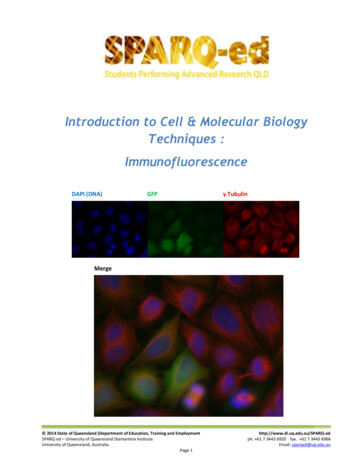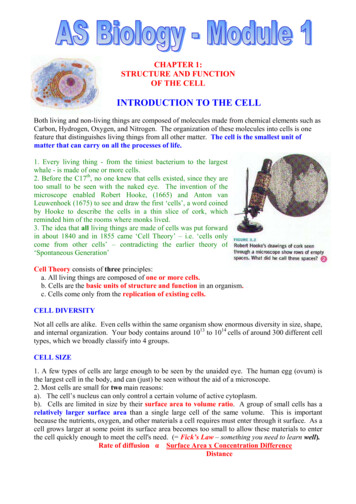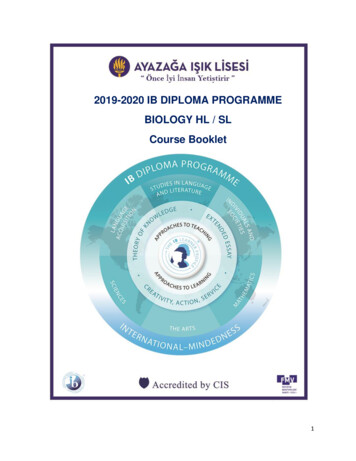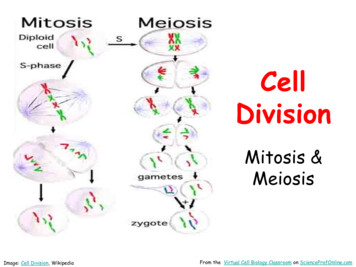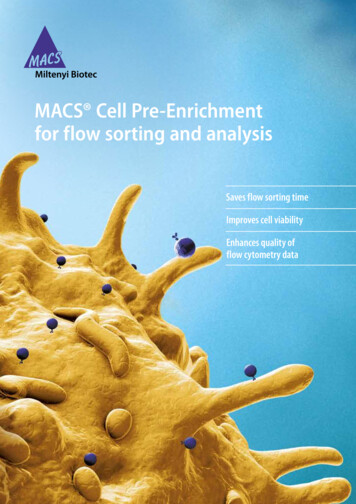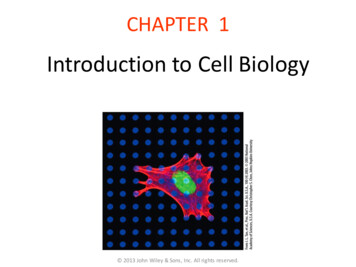
Transcription
CHAPTER 1Introduction to Cell Biology 2013 John Wiley & Sons, Inc. All rights reserved.
Keys Outline the early history of Cell Biology.Distinguish the basic properties of all cells.Describe the differences between prokaryotic and eukaryotic cells.Specify the types of prokaryotic cells.Emphasize cell specialization as it relates to eukaryotic cells.Discuss the relevance of multicellularity and the significance ofcellular differentiation.Review the dimensions important to Cell Biology.Clarify the structure and function of the different types of viruses.Define the mechanisms by which viral infections proceed.Explain the traits that distinguish viroids from viruses. 2013 John Wiley & Sons, Inc. All rights reserved.
Introduction Cells are the topic of intense study. The study of cells requires creative instruments andtechniques. Cell biology is reductionist, based on the premise thatstudying the parts of the whole can explain the character ofthe whole. 2013 John Wiley & Sons, Inc. All rights reserved.
(1.1) The Discovery of CellsHooke: double lens microscope The discovery ofcells followed fromthe invention of themicroscope byRobert Hooke, andits refinement byAnton Leewenhoek.Leewenhoek: single lensmicroscope Cell theory was articulated in the mid-1800s by Schleiden,Schwann and Virchow.– All organisms are composed or one or more cell.– The cell is the structural unit of life.– Cells arise from pre-existing cells by division. 2013 John Wiley & Sons, Inc. All rights reserved.
(1.2) Basic Properties of Cells Life is the most basicproperty of cells. Cells can grow andreproduce in culturefor extended periods.– HeLa cells are culturedtumor cells isolatedfrom a cancer patient(Henrietta Lacks) byGeorge Gey in 1951.– Cultured cells are anessential tool for cellbiologists.HeLa: first human cells for extended culturing 2013 John Wiley & Sons, Inc. All rights reserved.
Basic Propertiesof Cells Cells Are HighlyComplex andOrganized– Cellular processesare highly regulated.– Cells from differentspecies sharesimilar structure,composition andmetabolic featuresthat have beenconservedthroughoutevolution.Levels of cellular and molecular organization 2013 John Wiley & Sons, Inc. All rights reserved.
Basic Propertiesof Cells Cells Possess aGenetic Programand the Means toUse It– Genes encodeinformation to buildeach cell, and theorganism.– Genes encodeinformation forcellularreproduction,activity, andstructure.Levels of cellular and molecular organization 2013 John Wiley & Sons, Inc. All rights reserved.
Basic Properties of Cells Cells Are Capable ofProducing More ofThemselves– Cells reproduce, andeach daughter cellsreceives a complete setof genetic instructions.Mammalian oocyte after unequal celldivision to produce polar body (arrow) 2013 John Wiley & Sons, Inc. All rights reserved.
Basic Properties of Cells Cells Acquire and Utilize Energy– Photosynthesis provides fuel for all living organisms.– Animal cells derive energy from the products of photosynthesis,mainly in the form of glucose.– Cell can convert glucose into ATP—a substance with readily availableenergy. 2013 John Wiley & Sons, Inc. All rights reserved.
Basic Properties of Cells Cells Acquire and UtilizeEnergy Cells Carry Out a Variety ofChemical Reactions Cells Engage in MechanicalActivities Cells Are Able to Respondto Stimuli Cells Are Capable of SelfRegulation Cells EvolveSpirogyra: alga with ribbon-likechloroplast for photosynthesis 2013 John Wiley & Sons, Inc. All rights reserved.
Basic Properties of Cells Cells Acquire and UtilizeEnergy Cells Carry Out a Variety ofChemical Reactions Cells Engage in MechanicalActivities Cells Are Able to Respondto Stimuli Cells Are Capable of SelfRegulation Cells EvolveSelf-regulated development in thesea urchin during normal (L) andcell separation experiments (R) 2013 John Wiley & Sons, Inc. All rights reserved.
Basic Properties of Cells Cells Acquire and UtilizeEnergy Cells Carry Out a Variety ofChemical Reactions Cells Engage in MechanicalActivities Cells Are Able to Respondto Stimuli Cells Are Capable of SelfRegulation Cells EvolveCellular activities as a sequentialseries of events or ‘chain reaction.’ 2013 John Wiley & Sons, Inc. All rights reserved.
(1.3) Two Fundamentally DifferentClasses of Cells Prokaryotic andeukaryotic aredistinguished by theirsize and type oforganelles. Prokaryotes are allbacteria, which arose 3.7 billion years ago. Eukaryotes includeprotists, animals,plants and fungi.Bio-geological clock: Proposed appearancetime for major groups of organisms 2013 John Wiley & Sons, Inc. All rights reserved.
Comparison: Prokaryotic & Eukaryotic Cells 2013 John Wiley & Sons, Inc. All rights reserved.
Comparison: Prokaryotic & Eukaryotic Cells 2013 John Wiley & Sons, Inc. All rights reserved.
Basic Properties of Cells Characteristics that distinguish prokaryotic and eukaryotic cells– Complexity: Prokaryotes are relatively simple; eukaryotes are more complexin structure and function.– Cytoplasm: Eukaryotes have membrane-bound organelles and complexcytoskeletal proteins. Both have ribosomes but they differ in size.– Cellular reproduction: Eukaryotes divide by mitosis; prokaryotes divide bysimple fission.– Locomotion: Eukaryotes use both cytoplasmic movement, and cilia andflagella; prokaryotes have flagella, but they differ in both form andmechanism.– Genetic material: Packaging: Prokaryotes have a nucleoid region whereas eukaryotes have amembrane-bound nucleus. Amount: Eukaryotes have much more genetic material than prokaryotes. Form: Eukaryotes have many chromosomes made of both DNA and proteinwhereas prokaryotes have a single, circular DNA. 2013 John Wiley & Sons, Inc. All rights reserved.
The structure of cellsBacterium 2013 John Wiley & Sons, Inc. All rights reserved.
The structure of cellsPlant cell 2013 John Wiley & Sons, Inc. All rights reserved.
The structure of cellsAnimal cell 2013 John Wiley & Sons, Inc. All rights reserved.
Eukaryotic cell structure: Epithelial cell from the male rat reproductive tract 2013 John Wiley & Sons, Inc. All rights reserved.
Cytoplasm: A crowded compartmentin a eukaryotic cellCytoskeleton: RedRibosomes: GreenCell membrane: BlueColorized electron micrograph of afrozen single-celled eukaryote 2013 John Wiley & Sons, Inc. All rights reserved.
Cellular reproduction:Eukaryotes and prokaryotesCell division in eukaryotesDNA (blue) and microtubules(green) of two daughter cells. 2013 John Wiley & Sons, Inc. All rights reserved.Bacterial conjugationSharing of DNA throughthe F pilus
Flagella: differences betweenprokaryotes and eukaryotesLow magnificationHighSEMTEM: cross sectionSalmonella bacteriumMultiple flagella for locomotionHuman sperm cellsSingle flagella 2013 John Wiley & Sons, Inc. All rights reserved.
Basic Properties of Cells Types of Prokaryotic Cells1. Domain Archaea: Methanogens, Halophiles, Acidophiles, Thermophiles2. Domain Bacteria Includes the smallest known cells – mycoplasmaIncludes cyanobacteria – some photosynthetic bacteria Cyanobacteria gave rise to green plants and an oxygen-rich atmosphere. Some bacteria capable of nitrogen fixation.Cyanobacteria: electron micrographCyanobacteria in polar bear coats 2013 John Wiley & Sons, Inc. All rights reserved.
Basic Properties of Cells Prokaryotic Diversity– Prokaryotes are identified and classified on the basis of specificDNA sequences.– Recent evidence indicates that prokaryotes are more diverse andnumerous than previous thought. 2013 John Wiley & Sons, Inc. All rights reserved.
Basic Properties of Cells Types of Eukaryotic Cells:Cell Specialization– Unicellular eukaryotes arecomplex single-celledorganisms. Vorticella have acontractile ribbon in thestalk and a largemacronucleus (arrow infigure) that containsmultiple copies of its genes.Vorticella, a complex ciliated protist 2013 John Wiley & Sons, Inc. All rights reserved.
Basic Properties of Cells Types of Eukaryotic Cells:Cell Specialization– Multicellular eukaryoteshave different cell typesfor different functions. Differentiation occursduring embryonicdevelopment in othermulticellular organisms. Numbers andarrangements oforganelles relate to thefunction of the cell. Despite differentiation,cells have many featuresin common.Pathways of cell differentiation 2013 John Wiley & Sons, Inc. All rights reserved.
Basic Properties of Cells: Model OrganismsEscherichia coli (bacterium)Caenorhabditis elegans(nematode)Saccharomyces (yeast)Drosophila (fruit fly) 2013 John Wiley & Sons, Inc. All rights reserved.Arabidopsis (mustard plant)Mus musculus (mouse)
The Human Perspective:The Prospect of Cell Replacement TherapyAdult muscle stemcell (yellow) presentin differentiatedmuscle fiber withstained blue nuclei.Adult muscle stemcells differentiatinginto adipose cells inculture. Stem cells are undifferentiated cells capable of self-renewal anddifferentiation.– Adult stem cells can be used to replace damaged or diseased adult tissue. Hematopoietic stem cells can produce blood cells in bone marrow. Neural stem cells may be sued to treat neurodegenerative disorders. 2013 John Wiley & Sons, Inc. All rights reserved.
The Human Perspective:The Prospect of Cell Replacement Therapy Embryonic stem (ES) cellshave even greater potentialfor differentiation(pluripotent) than adultstem cells.– ES cells must bedifferentiated in vitro.– The use of ES cells involvesethical considerations.Isolation of ES cells from blastocysts 2013 John Wiley & Sons, Inc. All rights reserved.
The Human Perspective:The Prospect of Cell Replacement Therapy Embryonic stem (ES) cellshave even greaterpotential fordifferentiation(pluripotent) than adultstem cells.– ES cells must bedifferentiated in vitro.– The use of ES cells involvesethical considerations.A procedure for obtaining differentiatedcells for use in cell replacement therapy 2013 John Wiley & Sons, Inc. All rights reserved.
The Human Perspective:The Prospect of Cell Replacement Therapy Induced pluripotent (iPS)cells has beendemonstrated in culture.– Involves reprogramming afully differentiated cell intoa pluripotent stem cell.– These cells have been usedto correct certain diseaseconditions in experimentalanimals.– Studies to reveal themechanism of iPS couldhave significant medicalapplications.Steps taken to generate iPS for use in correctingthe inherited disease sickle cell anemia in mice 2013 John Wiley & Sons, Inc. All rights reserved.
Basic Propertiesof Cells The Sizes of Cells and TheirComponents– Cells are commonly measuredin units of micrometers (1 μm 10–6 meter) and nanometers(1 nm 10–9 meter).– Cell size is limited: By the volume of cytoplasmthat can be supported by thegenes in the nucleus. By the volume of cytoplasmthat can be supported byexchange of nutrients. By the distance over whichsubstances can efficientlytravel through the cytoplasmvia diffusion.Relative sizes of cells and cell components 2013 John Wiley & Sons, Inc. All rights reserved.
Basic Properties of Cells Synthetic Biology is a fieldoriented to create a livingcell in the laboratory.– A more modest goal is todevelop novel life forms,beginning with existingorganisms.– Possible applications tomedicine, industry, or theenvironment.– Prospect is good afterreplacing the genome ofone bacterium with that of aclosely related species.Synthetic biology toolbox:Nucleic acids, proteins, and lipids 2013 John Wiley & Sons, Inc. All rights reserved.
(1.4) Viruses Viruses are pathogens. Viruses are intracellular obligateparasites. A virion is a virus particle outside thehost cell. Viral structure:– Genetic material and can be singlestranded DNA or RNA.– Protein capsid surrounds the geneticmaterial.– A lipid envelope may surround thecapsid in some viruses. Viroids are pathogens, eachconsisting of a small, naked RNAmolecule. Viroids cause disease by interferingwith gene expression in host cells.RNA-based Tobacco mosaic virus (TMV)Electron microscopy: TVM 2013 John Wiley & Sons, Inc. All rights reserved.
Viruses: Host infection diversityAdenovirusHuman immunodeficiencyvirus (HIV)T-even bacteriophage Virus and host– Viruses have surface proteins that bind to the surface of the host cell.– Viral specificity for a certain host is determined by the virus’ surfaceproteins. 2013 John Wiley & Sons, Inc. All rights reserved.
Viruses Viral infection types:– Lytic infection: the virusredirects the host into makingmore virus particles, the hostcell lyses and releases theviruses.– Integration: the virus integratesits DNA (called a provirus) intothe host cell’s chromosomes.Bacteriophage infection of bacterium(late stage) Infected host may behavenormally until externalstimulus activates provirus,leading to lysis. Host may give rise to viralprogeny by budding. Host may become malignant.HIV infection of human lymphocyte(late stage) 2013 John Wiley & Sons, Inc. All rights reserved.
Experimental Pathways:The Origin of Eukaryotic Cells Prokaryotic cells arose firstand gave rise to eukaryoticcells. Endosymbiont Theory:organelles in eukaryoticcells (mitochondria andchloroplasts) evolved fromsmaller prokaryotic cells.A model depicting possible steps inendosymbiosis 2013 John Wiley & Sons, Inc. All rights reserved.
Experimental Pathways:The Origin of Eukaryotic Cells Evidence to support endosymbiont theory– Absence of eukaryote species with organelles in an intermediatestage of evolution.– Many symbiotic relations are known among different organisms.– Organelles of eukaryotic cells contain their own DNA.– Nucleotide sequences of rRNAs from eukaryotic organellesresembled that of prokaryotes.– Organelles duplicate independently of nucleus.Two-dimensional gel fingerprint ofa T1 digest of chloroplast 16Sribosomal RNA 2013 John Wiley & Sons, Inc. All rights reserved.
Nucleotide Sequence Similarities Between RepresentativeMember of the Three Primary Kingdoms 2013 John Wiley & Sons, Inc. All rights reserved.
Experimental Pathways:The Origin of Eukaryotic Cells New ideas about the origin of eukaryotic cells– Based on nucleotide sequences of single genes, Woese proposedthree major cell lineages: Bacteria: include Gram positive, Gram negative, and cyanobacteria. Archaea: include halophiles, thermophiles, methanogens and acidophiles. Eucarya: include plants, animals, fungi, and protists. 2013 John Wiley & Sons, Inc. All rights reserved.
Experimental Pathways:The Origin of Eukaryotic CellsA phylogenetic showingbased on rRNA sequencecomparisons showingthe three domains of life Based on whole genomes, many organisms appear to be genetic mosaics.– Lateral gene transfer (LGT) results in organisms with both parental DNA andDNA from other organisms in the environment.– Bacteria and Eucarya show evidence of LGT in their genomes. 2013 John Wiley & Sons, Inc. All rights reserved.
Copyright 2013 John Wiley & Sons, Inc.All rights reserved. Reproduction or translation of this workbeyond that permitted in section 117 of the 1976 UnitedStates Copyright Act without express permission of thecopyright owner is unlawful. Request for further informationshould be addressed to the Permissions Department, JohnWiley & Sons, Inc. The purchaser may make back-up copiesfor his/her own use only and not for distribution or resale.The Publisher assumes no responsibility for errors,omissions, or damages caused by the use of these programsor from the use of the information herein. 2013 John Wiley & Sons, Inc. All rights reserved.
Emphasize cell specialization as it relates to eukaryotic cell s. Discuss the relevance of multicellularity and the signific ance of cellular differentiation. Review the dimensions important to Cell Biology. Clarify the structure and function of the different types of viruses. Define the mechanisms by which viral infections proceed .

